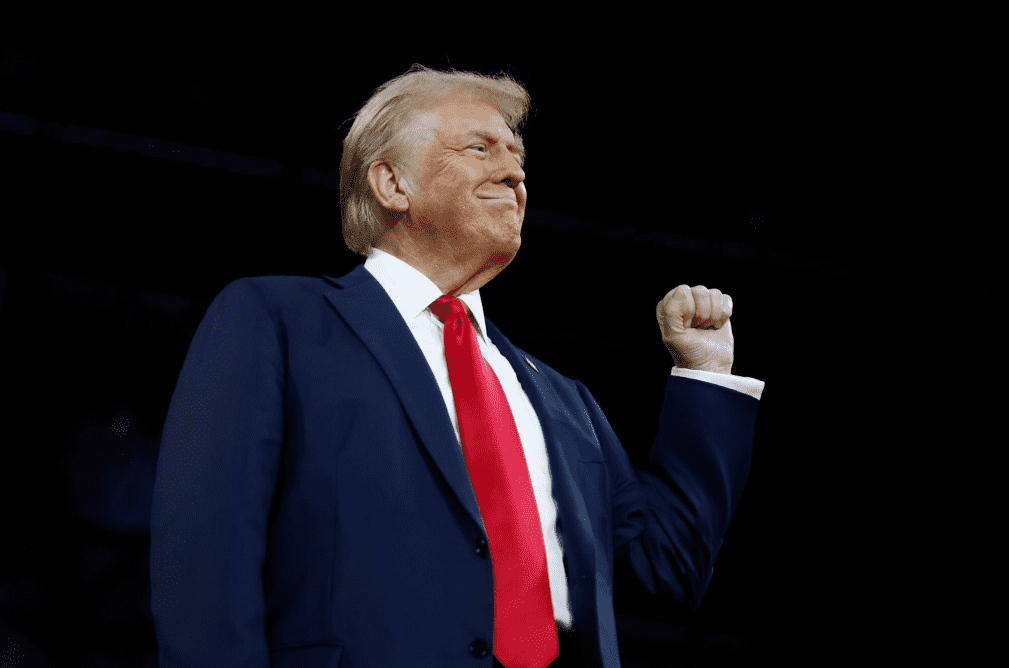Everything you need to know about the US Election 2024 – Potential Impact on Stock Market, International Relationships & Global Economy


The United States is the largest economy in the world with Gross Domestic product (GDP) of $29.17 Trillion.
Due to the influence on economic, political, and security issues that U.S. has on the world, it is no wonder that the U.S president election draws global attention.
While the entire U.S. election can be lengthy and complex, our aim is to break down the key highlights in a concise, approachable way—one that won’t take more than 10 minutes of your time!
What Is the Status of the US Election So Far? Donald Trump vs Kamala Harris
As the U.S. presidential election inches closer, both polling data and electoral predictions of the winner for this election remain close between candidates.
As of the point of this article, Former President Donald Trump holds a narrow lead over Vice President Kamala Harris in several key swing states, including Arizona, Georgia, Pennsylvania, Nevada, and Wisconsin.
A swing state is where both major political parties have similar levels of support among voters. These swing states could be decisive in the outcome of the election. At the moment, polling data in these areas show trends that favour Trump, while Harris, however, holds a slight national polling lead overall. This suggests a very tight race for the 2024 U.S. presidential election.
The current national polls indicate a virtual tie, with Kamala Harris and Donald Trump each securing around 48-49% of likely voters.
Key battleground states such as Pennsylvania, Georgia, and Arizona show slight leads shifting back and forth, reflecting the intensely competitive nature of the race. Both candidates are focusing on crucial last-minute rallies, with Harris emphasizing unity and Trump appealing to nostalgia for his prior term.
Ultimately, the election will hinge on voter turnout in these swing states.
The electoral college projections estimate that Trump currently has around 235 likely electoral votes, with Harris close at 226. This distribution reflects that neither candidate has a firm grip on the 270 electoral votes needed to secure victory, keeping the outcome uncertain and reliant on the final decisions of swing-state voters.
Additionally, the chance of an electoral tie at 269-269, while rare, remains a remote possibility.
What Is the US Presidential Election Timeline and When Will the Next President Take Office?
The U.S. presidential election follows a structured timeline, leading up to the official inauguration of the next president.
Here’s are some of the key dates:
- 5 November 2024
Election Day: The general election happens on the first Tuesday of November. This is when voters across the country cast their ballots to determine the next president. Most states open their polls at 7am local time. - 16 December 2024
Electoral College Vote: After the election, the electors of each state convene to cast their official votes for president and vice president. This step formally designates the president-elect. - 6 January 2025
Certification of Electoral Votes: Congress will then meet in a joint session to certify the electoral votes and formally declare the winner of the presidential election. This finalises the election results. - 20 January 2025
Inauguration Day: The president-elect takes the oath of office in the noon, officially beginning their term as the next president of the United States
This timeline may appear lengthy, but it is necessary in ensuring an orderly transition of power, allowing the new administration to prepare for governance and assume office smoothly.
The Global Impact of the 2024 U.S. Presidential Election
The 2024 U.S. presidential election has significant global implications, affecting areas like trade, climate policy, defense alliances, and economic stability.
A Trump Victory
A Trump victory may lead to a return to "America First" policies.
These are policies that set sight on America’s national interests and potentially renegotiating trade deals, which could create uncertainty for allies and trading partners.
A Harris Victory
A Harris administration would likely emphasize climate action and reinforce multilateral relationships, such as with NATO and international institutions.
These policies could stabilize global markets and foster collaborative approaches on issues like climate change and security challenges in Europe and Asia.
What Impact will the 2024 U.S. Presidential Election have on the stock market?
The 2024 U.S. presidential election could trigger notable volatility in the stock market, largely due to differing economic policies from the candidates.
If Trump wins, markets might see short-term boosts in sectors like energy and defense due to his business-focused, deregulation-oriented approach. However, concerns over trade disruptions could create fluctuations.
Conversely, a Harris victory could promote stability in renewable energy stocks and tech sectors, with an emphasis on climate initiatives and multilateral trade relations, though potential tax increases might unsettle some investors.
Ultimately, investor sentiment and policy outcomes will dictate market performance.
What would a Kamala Harris victory mean?
A Kamala Harris victory in the 2024 U.S. presidential election could have nuanced effects on both international relations and the U.S. stock market. Her policies are likely to reinforce the current administration goals while also introducing shifts that could impact certain sectors and the global economic landscape.
What does Kamala Harris Victory mean to U.S. International Relations
Harris is expected to maintain and potentially expand U.S. positions on issues like democracy and human rights, especially in interactions with China and Russia.
This would likely include but not limited to sanctions aimed at third-party entities that support Russia indirectly, such as companies in countries that facilitate economic exchanges with Russia.
In addition, Harris has shown strong support for the Uyghur Forced Labor Prevention Act, targeting goods produced with forced labor, specifically in China, which could lead to stricter trade regulations affecting global supply chains, particularly for textiles and technology.
In terms of alliances, Harris’ administration would likely reinforce NATO and other security partnerships, emphasizing collective defense.
Harris is also expected to bolster relations with Indo-Pacific allies like Japan, South Korea, and Australia. This focus could increase defence spending and have a positive impact on defence contractors. On the other hand, such action can also strain U.S.-China relations further.
What does Kamala Harris Victory mean to Stock Market and Industries?
Markets could react cautiously to a Harris-led administration.
Investors are expecting what some call “Kamalanomics,” with Harris favouring fiscal policies that emphasize social spending and economic equity. This could mean tighter corporate regulations and potentially higher taxes for certain corporations.
Key sectors that are likely to benefit include clean energy, healthcare, and technology companies focusing on cybersecurity and infrastructure modernisation.
Conversely, industries reliant on global supply chains or imports, like consumer electronics and textiles, may be affected by potential increases in tariffs and stricter customs enforcement on goods tied to forced labour.
A focus on healthcare equity and lower pharmaceutical prices, aligned with Harris' earlier statements, may also affect healthcare stocks differently: pharmaceutical companies might experience pressure from proposed drug pricing caps, while companies in healthcare services and medical equipment might see increased demand due to new health initiatives.
Overall, a Harris victory would likely continue some aspects of Biden’s policy directions, with specific shifts that may present both opportunities and risks for various sectors depending on the administration’s regulatory and fiscal focus.
What would a Donald Trump victory mean?
If Donald Trump were to win the 2024 U.S. presidential election, the implications for international relations, the stock market, and specific industries could be significant. Here’s a breakdown of some of the likely impacts:
What would a Donald Trump victory mean for U.S. Foreign Relations?
A Trump administration is expected to revisit some of its former stances, possibly reapplying or increasing tariffs on Chinese goods and taking a tough stance on trade practices.
This could re-ignite trade tensions and lead to retaliatory tariffs, affecting global supply chains.
The European Union and other allies may also experience friction, as Trump has previously challenged the spending commitments and trade balances of NATO with these allies. Trump’s position on regions like the Middle East, East Asia, and Russia may prioritise a unilateral “America First” approach. This would potentially mean creating less collaborative international relationships, adding volatility to global markets, particularly in energy if tensions rise with oil-producing nations.
What would a Donald Trump victory mean for the Stock Market?
Historically, markets have reacted positively to Trump’s pro-business policies, especially those favouring lower corporate taxes and deregulation.
Analysts expect that another Trump term could continue this bullish momentum for sectors that will benefit from reduced regulatory oversight.
Here are some Sector-Specific Effects that could arise from Trump’s administration:
- Energy: Fossil fuel companies may see gains, as Trump has consistently favoured domestic oil and gas production. Deregulation could lower operational costs, benefit pipeline infrastructure, and encourage more fossil fuel production. This might limit growth in the renewable energy sector compared to a Harris administration, which would likely favour green energy incentives.
- Financials: Trump’s corporate tax cut plans and a favourable regulatory environment could boost financial stocks. Proposals to lower corporate taxes further (potentially to 15%) and loosen merger and acquisition regulations may create a positive outlook for banks and financial institutions.
- Manufacturing and Defence: Military and defence spending may increase under Trump’s administration, potentially benefiting defense contractors and relevant manufacturing industries. Additionally, Trump’s policies that support American-made goods over imports, may continue to benefit domestic manufacturers.
What would a Donald Trump victory mean for the Global Economic?
Sectors reliant on stable trade agreements, like agriculture, could face uncertainty, particularly with key export markets like China and Europe. Technology companies may also be affected by potential trade restrictions on electronics and software exports.
Rising import tariffs on consumer goods could increase prices for U.S. consumers and may decrease demand, which could impact retail stocks. This potential decrease in consumer spending might affect the broader economy if trade wars escalate.
In summary, a Trump victory could result in a continuation of protectionist policies, benefiting U.S. energy and financial sectors while creating potential strains in international alliances. Trade tensions could bring market volatility, particularly in sectors exposed to global supply chains and international trade, such as technology and agriculture.








